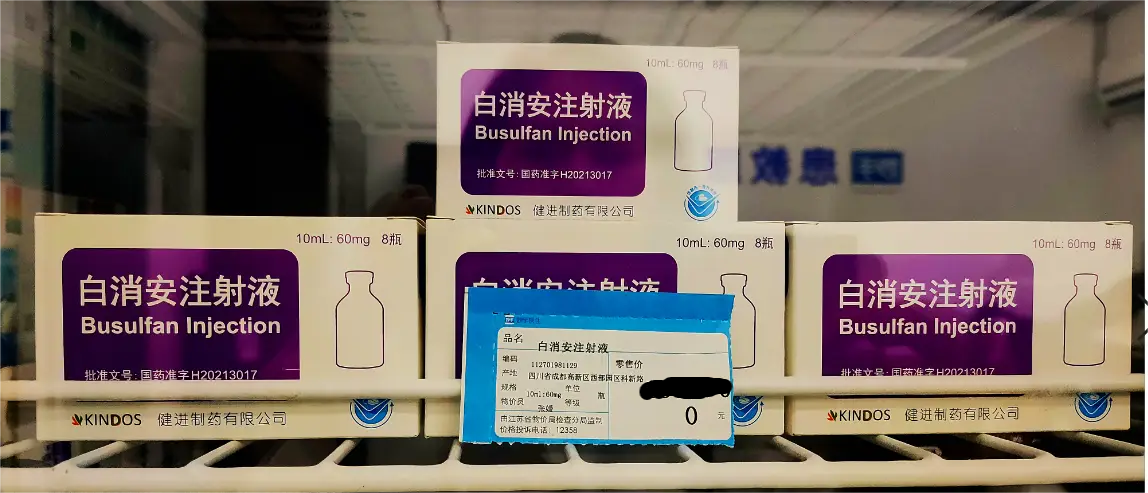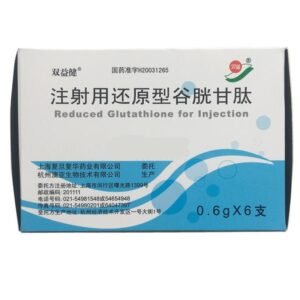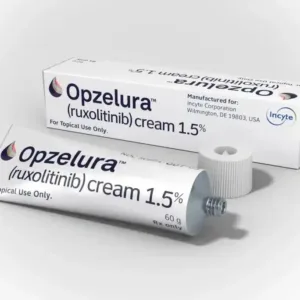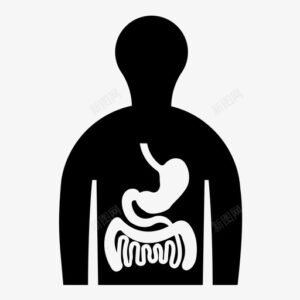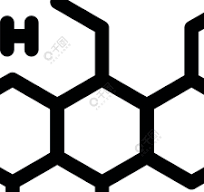Busulfan
Effects and efficacy:
Different dosage forms of busulfan have different indications. Busulfan tablets: used in the chronic phase of chronic myeloid leukemia, and are not effective for patients lacking the Philadelphia chromosome Ph1. It can also be used to treat chronic myeloproliferative diseases such as essential thrombocythemia and polycythemia vera. Busulfan injection: used in combination with cyclophosphamide as a pretreatment regimen before allogeneic hematopoietic progenitor cell transplantation for chronic myeloid leukemia.
Usage and dosage:
Common dosage of busulfan tablets for adults: chronic myeloid leukemia, total daily amount 4-6 mg/m2, once a day. If the white blood cell count drops to 20×109/L, the drug should be discontinued as appropriate. Or give a maintenance dose of 1-2 mg daily or every other day to maintain the white blood cell count at around 10×109/L. Busulfan injection should be administered through a central venous catheter, and each dose requires an infusion of 2 hours, once every 6 hours for 4 consecutive days, for a total of 16 times. Cyclophosphamide was given 60 mg/kg intravenously over 1 hour once a day for 2 days 3 days before bone marrow transplantation, 6 hours after the 16th dose of this product. All patients should be given phenytoin prophylactically because busulfan is known to cross the blood-brain barrier and induce epilepsy. Phenytoin reduces the plasma AUC of busulfan by 15%; other anticonvulsants may increase the plasma AUC of busulfan, thereby increasing the risk of hepatic veno-occlusive disease or epilepsy. If other anticonvulsants must be used, plasma busulfan exposure should be monitored. Antiemetics should be given before the first start and continued throughout the medication period according to a certain plan. The clearance of this product is most predictable when it is administered according to calibrated ideal body weight. If the dose of this product is calculated based on actual body weight, ideal body weight or other factors, it may result in significant differences in clearance between lean, normal and obese patients. When forming a pretreatment regimen for bone marrow or peripheral blood progenitor cell transplantation, the adult dose of this product is usually 0.8 mg/kg, taking the lower value of ideal body weight or actual body weight, and administering it once every 6 hours for 4 consecutive days (a total of 16 times). For obese or extremely obese patients, this product should be administered according to the calibrated ideal body weight. The calculation formula for ideal body weight (IBW) is as follows (height cm, weight kg): IBW (kg, male) = 50 + 0.91 (height cm-152), IBW (kg, female) = 45 + 0.91 (height cm-152). The calibrated ideal body weight (AIBW) formula is: AIBW = IBW + 0.25 (actual body weight – IBW).
Adverse reactions:
Busulfan tablets can produce bone marrow suppression. Common symptoms are granulocytopenia and thrombocytopenia. Severe cases require timely discontinuation of the drug. Long-term use or excessive use of the drug can cause pulmonary fibrosis. There may be skin pigmentation, hyperuricemia and sexual dysfunction, feminization of male breasts, testicular atrophy, and irregular menstruation in women. Cataracts, erythema multiforme rash, and polyarteritis nodosa are rare adverse reactions. There have been individual reports of epileptic seizures after high doses; endocardial fibrosis, and the corresponding symptoms; and rare hepatic venous atresia. The following section of busulfan injection describes clinically significant adverse events in clinical trials of this product, regardless of whether they are caused by the drug. Hematological system: Under the recommended dosage regimen, this product causes 100% of patients to have deep bone marrow suppression, severe agranulocytosis, thrombocytopenia, anemia, etc., so blood counts must be monitored during treatment until recovery. Gastrointestinal tract: Gastrointestinal toxicity is very common and is generally considered to be drug-related. Only a few are classified as severe toxicity. In allogeneic transplant clinical trials, 92% of patients experienced mild or moderate nausea, 95% of patients experienced mild or moderate vomiting, and 7% experienced severe nausea by 28 days after transplantation. In allogeneic transplant clinical trials, the incidence of vomiting during the administration of this product (7 days before transplantation to 4 days before transplantation) was 43%. Grade 3-4 stomatitis occurred in 26% of patients and grade 3 esophagitis in 2%. Grade 3-4 diarrhea occurred in 5% of patients in the allogeneic trial, and mild to moderate diarrhea occurred in 75%. Mild to moderate constipation occurred in 38% of patients, and ileus occurred in 8% of patients and was severe in 2%. Mild to moderate dyspepsia was reported in 44% of patients. Hematemesis occurred in 2% of patients. Pancreatitis occurred in 2% of patients. Mild to moderate rectal discomfort was seen in 24% of patients. Severe anorexia was seen in 21% of patients and mild to moderate in 64% of patients. Liver: Hyperbilirubinemia occurred in 49% of patients in the allogeneic stem cell transplantation trial. Grade 3 or 4 hyperbilirubinemia occurred in 30% of patients within 28 days of transplantation, of which 5% were life-threatening. Hyperbilirubinemia was associated with graft-versus-host disease in 6 patients and with hepatic veno-occlusive disease in 5 patients. Grade 3/4 elevations of SGPT were seen in 7% of patients. Mild to moderate elevations in alkaline phosphatase were seen in 15% of patients. Mild to moderate jaundice occurred in 12% of patients, and hepatomegaly occurred in 6%. Hepatic veno-occlusive disease: Hepatic veno-occlusive disease (HVOD) is a potential complication of pre-transplant conditioning. Graft-versus-host disease: In allogeneic studies, graft-versus-host disease (GVHD) occurred in 18% of patients; 3% were severe, 15% were mild to moderate, and severe cases could be life-threatening. Edema: 79% of patients experienced some form of edema, hypervolemia, or weight gain; all events were reported as mild to moderate. Infection/fever: 51% of patients experienced 1 or more infections. One patient had fatal pneumonia, while pneumonia was life-threatening in 3% of patients. Fever occurred in 80% of patients, 78% were mild to moderate, and 3% were severe. Chills were experienced in 46% of patients. Cardiovascular system: Mild to moderate tachycardia was reported in 44% of patients. Seven patients (11%) first reported it during administration of this product. Other arrhythmias were mild to moderate and included arrhythmias (5%), atrial fibrillation (2%), ventricular premature beats (2%), and third-degree block (2%). Mild or moderate thrombosis occurred in 33% of patients, all of which were related to central venous catheters. Hypertension was reported in 36% of patients, including grade 3/4 in 7%. Hypotension was reported in 11% of patients, grade 3/4 in 3%. Mild vasodilation (flushing or hot spots) was reported in 25% of patients. Other cardiovascular events included myocardial hypertrophy (5%), mild electrocardiographic abnormalities (2%), grade 3/4 left heart failure (1 patient, 2%), and moderate pericardial effusion (2%). Most of these events were reported after the use of cyclophosphamide. Pulmonary: Mild or moderate dyspnea occurred in 25% of patients and severe dyspnea in 2%. Severe hyperventilation occurred in 1 patient (2%); the other 2 patients (3%) were mild to moderate. Mild rhinitis and mild to moderate cough were reported by 44% and 28% of patients, respectively. Mild epistaxis was reported by 25% of patients. In the allogeneic study, 3 patients (5%) were confirmed to have alveolar hemorrhage, all of whom required mechanical ventilation support and eventually died; another patient was found to have nonspecific pulmonary interstitial fibrosis by electronic thoracoscopic wedge biopsy and died of respiratory failure 98 days after transplantation. Other pulmonary adverse events were mild or moderate, including pharyngitis (18%), hiccups (18%), asthma (8%), atelectasis (2%), pleural effusion (3%), hypoxemia (2%), hemoptysis (3%) and sinusitis (3%). Nervous system: The most reported adverse events of the central nervous system were insomnia (84%), anxiety (75%), dizziness (30%) and depression (23%); except for 1 patient (1%) who had severe insomnia, the above adverse reactions were mild or moderate. One patient (1%) experienced life-threatening cerebral hemorrhage and coma in the end-stage of multi-organ failure secondary to HVOD. Other severe adverse events included: delirium (2%), agitation (2%), and encephalopathy (2%). The overall incidence of delirium was 11%, and 5% of patients reported hallucinations. In patients who experienced delirium and hallucinations in the allogeneic studies, their delirium occurred at the completion of tadalafil dosing. In the allogeneic clinical studies of tadalafil, the overall incidence of sleepiness was 7%, and the incidence of somnolence was 2%. In the autotransplantation study, despite the administration of phenytoin prophylaxis, 1 patient still had a seizure during cyclophosphamide administration. Renal: 21% of patients had mild to moderate increases in serum creatinine. 3% of patients had increased blood urea nitrogen (BUN), and 2% of patients had grade 3/4 increases. 7% of patients had dysuria, 15% had oliguria, and 8% had hematuria. In the allogeneic clinical trials, there were 4 cases (7%) of grade 3/4 hemorrhagic cystitis. Skin: Rash (57%) and pruritus (28%) were reported, with the majority of both events being mild. Mild alopecia was reported in 15% of patients and moderate in 2%. Mild herpes was reported in 10% of patients and mild to moderate maculopapular rash in 8%. Bullae were reported in 10% of patients and exfoliative dermatitis in 5%. Erythematous nodules were reported in 2% of patients, acne in 7%, and skin depigmentation in 8%. Metabolic: Hyperglycemia was reported in 67% of patients and Grade 3/4 hyperglycemia in 15%. Mild to moderate hypomagnesemia was reported in 77% of patients; mild to moderate hypokalemia in 62% and severe hypokalemia in 2%; mild to moderate hypocalcemia in 46% and severe hypocalcemia in 3%, mild to moderate hypophosphatemia in 17%, and hyponatremia in 2%. Death: In the allogeneic transplant study, 2 deaths occurred within 28 days after transplantation; an additional 6 deaths occurred between 29 days and 100 days after transplantation. Adverse reactions of dimethylacetamide (DMA): DMA is the solvent in the formula of this product. It may cause adverse reactions such as liver toxicity (manifested as increased transaminase SGOT) and nervous system toxicity (manifested as hallucinations). Hallucinations often occur one day after the completion of the DMA dosing plan and are accompanied by EEG changes. Other neurotoxicities include drowsiness, sleepiness, and mental confusion. However, it is difficult to determine the relative extent of the effects of DMA and/or other concomitant medications in the liver toxicity and neurotoxicity observed in the use of this product. Others: Other adverse events reported included headache (mild to moderate 46%, severe 5%), abdominal pain (mild to moderate 69%, severe 3%), asthenia (mild to moderate 49%, severe 2%), nonspecific pain (mild to moderate 43%, severe 2%), allergic reaction (mild to moderate 24%, severe 2%), injection site inflammation (mild to moderate 25%), injection site pain (mild to moderate 15%), chest pain (mild to moderate 26%), back pain (mild to moderate 23%), muscle pain (mild to moderate 16%), joint pain (mild to moderate 13%) and hearing impairment (3%).
Contraindications:
Contraindicated if allergic to this product, contraindicated during pregnancy, contraindicated during lactation
Share:
Products
Our offers
Health Classification
Let us work together to protect precious health

